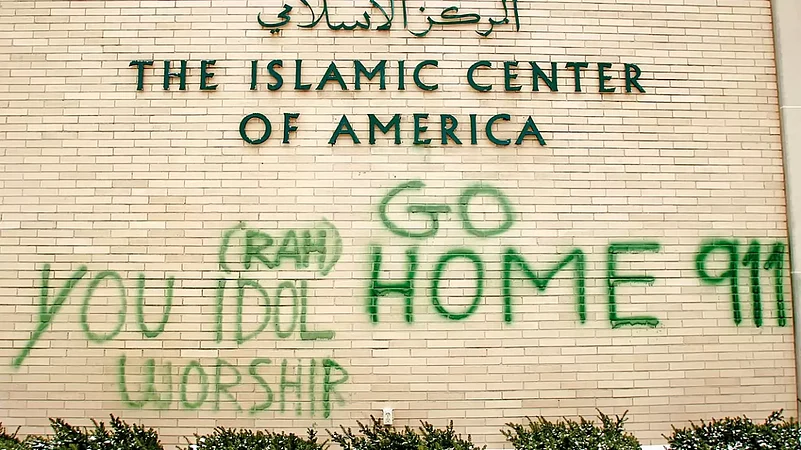ISLAMOPHOBIA is not confined just to India. Nor is it a new phenomenon. But since 9/11 and America’s War on Terror, Muslims have been under attack in Europe and America and across Asia, Australia, in short around the world. The tendency to see all Muslims as terrorists have made them the target of hate crimes. Samuel Huntington’s The Clash of Civilization helped to popularise the idea that Islamic culture could not co-exist with Christianity and fueled what is now popularly known as Islamophobia which, simply put, implies intense suspicion and “othering” of Muslims.
“A number of factors have played a role in the mainstreaming of Islamophobia, including the spread of conspiracy theories and misinformation on social media,” says Mobashra Tazamal, Associate Director of The Bridge Initiative at Georgetown University. “However, one of the primary reasons Islamophobia has been able to spread across the globe has been due to the role of governments and mainstream politicians who’ve adopted, promoted, and sanctioned anti-Muslim racism both in their rhetoric and in their policies. From France to India, we’ve seen leading politicians adopt prejudicial and discriminatory views about Islamophobia as a way to rile up a majoritarian base and scapegoat a community that is already marginalised. This has been a successful technique in garnering votes during election campaigns,’’ she explains.
The burning of the Quran in Sweden, terror attacks on mosques in Christchurch, New Zealand, desecration of Islamic graves, graffiti with hateful slogans such as “Muslims Go Home,” “Down with Muslims,” “Muslims, Islam=Cancer’’ are now commonplace. Muslim women are more prone to abuse for covering their hair or wearing a hijab. France has passed a law banning religious symbols including full face cover, like the nikab and the hijab in public places.
The anti-Islam narrative is being promoted by Right-Wing ideologues through think-tanks, political and socio-cultural groups, powerful sections of the media as well as political leaders who exploit the latent hate for votes.

Islamophobia has existed since the Middle Ages when the two major religions, Islam and Christianity, fought for supremacy in Europe during the Crusades. Negative stereotypes of Islam as a religion—that was violent, uncouth and uncivilised—was promoted to reinforce the fact that Christianity and the Western civilisation were a force for good. Stories and myths were spun around these warriors and kept alive in songs, myths and the written word.
In the early 1990s, Huntington’s thesis reignited the old debate. Huntington felt that with the dissolution of the Soviet Union in 1991, the ideological debate over capitalism versus communism was over and that future wars would be fought on civilisational and religious lines. Conflicts would not be over territory, but culture that is often defined by religion. Considering Islam and Christianity are two of the world’s most important religions, the clash of civilisation would be between them, much as it was in the old times but in a modern context. “Some Westerners […] have argued that the West does not have problems with Islam but only with violent Islamist extremists. Fourteen hundred years of history demonstrate otherwise,” says Huntington in The Clash of Civilizations and Remaking of World Order, clearly laying down the terms for George W Bush’s war on terror which was both timeless and borderless.
Islamophobia in the US was a result of 9/11 bombings that claimed as many as 2,977 lives. Earlier anti-Muslim sentiments did exist, but it was confined to individual dislike of Muslims. Nor was it apparent in public spaces. The pain and outrage after 9/11 turned the tide and President George Bush’s war on terror helped to crystallise the dislike and led to “othering” of Muslims. Critics have dubbed America’s terror war as the “Forever Wars”, as it was both a borderless and timeless campaign against Islamic terror. According to reports, the war stretched to about 40 per cent of the world, cost the US an estimated $8 trillion, and has killed roughly more than 900,000 people.
Governments around the world armed themselves with new surveillance measures to keep track of Muslims living in the country and extended it in many cases to political rivals. All was justified in the name of keeping the country safe. Laws like the Patriot Act, the Countering Violent Extremism Program, and Donald Trump’s executive order banning citizens from seven Muslim nations from coming to the US, was almost state-sanctioning of Muslims. Successive governments have armed themselves with laws to tap citizens’ phones and keep watch over “suspects” mainly Muslims. Spying on those opposed to the ruling government became regular in several countries. The excuse doled out always remained security. Back sliding of individual rights in the US, including torture, global drone strikes and the Guantanamo Bay military prison were all part of the new anti-terror measures to protect the US from Islamic terror groups. All this helped to shape the common citizens anti-Muslim views.
In a submission by the US to the United Nations Committee on Elimination of Racial Discrimination, a survey conducted on Islamophobia in the US, showed 97.8 per cent of respondents admitted that Islamophobia exists in the US. In assessing those most impacted by Islamophobia, almost three-quarters of participants (74.3 per cent) believed that women are more at risk of being targets of hateful remarks, possibly because of wearing the hijab or a head scarf.
Islamophobia is much more widespread in Europe than in the US. It started with the 9/11 attacks, but also had to do with the Syrian civil war that forced civilians caught in the conflict to flee to Europe. Al Qaeda, ISIS and other Islamic jihadi groups that sprouted after the Iraq war carried out major terror strikes in London, Paris, Calais, Barcelona and Brussels. The publication of the Prophet Muhammad cartoon in Denmark and its reproduction in the French satirical magazine Charlie Hebdo in January 2015, led to two Muslim brothers gunning down 12 editors and cartoonists and injuring several others. This resulted in a public outrage. The feeling in France, which had a large number of second and third generation Algerians and other Muslims from North African countries, ignited anti-Muslim sentiments. The fact that many of them live in crowded inner ghettoes across French cities and often indulged in violence thanks largely to police atrocities against them is often overlooked. Instead, the myth that violence is embedded within Islam takes root and is fanned by politicians.
Add to this is the economic distress triggered by climate change, the pandemic and failing governments in several African countries leading to more and more people rushing to Europe for a better life. Anti-immigrant, anti-Muslim rhetoric has led to former fringe politicians like Marine Le Pen becoming mainstream with the possibility of defeating Emmanuel Macron in next year’s presidential elections. Already far-Right groups are in power sometimes in coalition with the traditional Right in countries like Hungary, Italy, Finland, Sweden and Greece. Germany is also seeing a surge in popularity of the fringe right. So what is the way out?
“If we truly want to tackle Islamophobia, it must start at the top. Politicians must be held accountable for their rhetoric, international mechanisms need to be adopted to address Islamophobia at both structural and institutional levels, and there needs to be consequences for engaging in anti-Muslim racism. Currently, individuals engaging in Islamophobia are applauded and even rewarded for their bigoted actions. If this is the message being sent by the authorities, then everyday hate crimes at a local level will continue,” says Tazamal. Another way is to stop the spread of misinformation and to urge social media companies to seriously tackle the problem on their platforms. Currently, Islamophobic content is rampant on Twitter, Facebook, YouTube, WhatsApp, etc, and there seems to be little appetite in tackling this issue,’’ she adds.
(This appeared in the print as 'A Divided World')



























